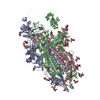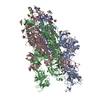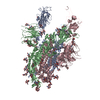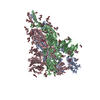[English] 日本語
 Yorodumi
Yorodumi- PDB-7eb4: Cryo-EM structure of SARS-CoV-2 Spike D614G variant, two RBD-up c... -
+ Open data
Open data
- Basic information
Basic information
| Entry | Database: PDB / ID: 7eb4 | |||||||||||||||
|---|---|---|---|---|---|---|---|---|---|---|---|---|---|---|---|---|
| Title | Cryo-EM structure of SARS-CoV-2 Spike D614G variant, two RBD-up conformation 1 | |||||||||||||||
 Components Components | Spike glycoprotein | |||||||||||||||
 Keywords Keywords | VIRAL PROTEIN / SARS-CoV-2 / Spike protein | |||||||||||||||
| Function / homology |  Function and homology information Function and homology informationMaturation of spike protein / viral translation / Translation of Structural Proteins / Virion Assembly and Release / host cell surface / host extracellular space / suppression by virus of host tetherin activity / Induction of Cell-Cell Fusion / structural constituent of virion / entry receptor-mediated virion attachment to host cell ...Maturation of spike protein / viral translation / Translation of Structural Proteins / Virion Assembly and Release / host cell surface / host extracellular space / suppression by virus of host tetherin activity / Induction of Cell-Cell Fusion / structural constituent of virion / entry receptor-mediated virion attachment to host cell / host cell endoplasmic reticulum-Golgi intermediate compartment membrane / receptor-mediated endocytosis of virus by host cell / membrane fusion / Attachment and Entry / positive regulation of viral entry into host cell / receptor-mediated virion attachment to host cell / receptor ligand activity / host cell surface receptor binding / symbiont-mediated suppression of host innate immune response / fusion of virus membrane with host plasma membrane / fusion of virus membrane with host endosome membrane / viral envelope / virion attachment to host cell / SARS-CoV-2 activates/modulates innate and adaptive immune responses / host cell plasma membrane / virion membrane / identical protein binding / membrane / plasma membrane Similarity search - Function | |||||||||||||||
| Biological species |  | |||||||||||||||
| Method | ELECTRON MICROSCOPY / single particle reconstruction / cryo EM / Resolution: 3.5 Å | |||||||||||||||
 Authors Authors | Yang, T.J. / Yu, P.Y. / Chang, Y.C. / Hsu, S.T.D. | |||||||||||||||
| Funding support |  Taiwan, 4items Taiwan, 4items
| |||||||||||||||
 Citation Citation |  Journal: J Biol Chem / Year: 2021 Journal: J Biol Chem / Year: 2021Title: D614G mutation in the SARS-CoV-2 spike protein enhances viral fitness by desensitizing it to temperature-dependent denaturation. Authors: Tzu-Jing Yang / Pei-Yu Yu / Yuan-Chih Chang / Shang-Te Danny Hsu /  Abstract: The D614G mutation in the spike protein of SARS-CoV-2 alters the fitness of the virus, leading to the dominant form observed in the COVID-19 pandemic. However, the molecular basis of the mechanism by ...The D614G mutation in the spike protein of SARS-CoV-2 alters the fitness of the virus, leading to the dominant form observed in the COVID-19 pandemic. However, the molecular basis of the mechanism by which this mutation enhances fitness is not clear. Here we demonstrated by cryo-electron microscopy that the D614G mutation resulted in increased propensity of multiple receptor-binding domains (RBDs) in an upward conformation poised for host receptor binding. Multiple substates within the one RBD-up or two RBD-up conformational space were determined. According to negative staining electron microscopy, differential scanning calorimetry, and differential scanning fluorimetry, the most significant impact of the mutation lies in its ability to eliminate the unusual cold-induced unfolding characteristics and to significantly increase the thermal stability under physiological pH. The D614G spike variant also exhibited exceptional long-term stability when stored at 37 °C for up to 2 months. Our findings shed light on how the D614G mutation enhances the infectivity of SARS-CoV-2 through a stabilizing mutation and suggest an approach for better design of spike protein-based conjugates for vaccine development. | |||||||||||||||
| History |
|
- Structure visualization
Structure visualization
| Movie |
 Movie viewer Movie viewer |
|---|---|
| Structure viewer | Molecule:  Molmil Molmil Jmol/JSmol Jmol/JSmol |
- Downloads & links
Downloads & links
- Download
Download
| PDBx/mmCIF format |  7eb4.cif.gz 7eb4.cif.gz | 563 KB | Display |  PDBx/mmCIF format PDBx/mmCIF format |
|---|---|---|---|---|
| PDB format |  pdb7eb4.ent.gz pdb7eb4.ent.gz | 459.2 KB | Display |  PDB format PDB format |
| PDBx/mmJSON format |  7eb4.json.gz 7eb4.json.gz | Tree view |  PDBx/mmJSON format PDBx/mmJSON format | |
| Others |  Other downloads Other downloads |
-Validation report
| Summary document |  7eb4_validation.pdf.gz 7eb4_validation.pdf.gz | 2.3 MB | Display |  wwPDB validaton report wwPDB validaton report |
|---|---|---|---|---|
| Full document |  7eb4_full_validation.pdf.gz 7eb4_full_validation.pdf.gz | 2.3 MB | Display | |
| Data in XML |  7eb4_validation.xml.gz 7eb4_validation.xml.gz | 82.1 KB | Display | |
| Data in CIF |  7eb4_validation.cif.gz 7eb4_validation.cif.gz | 124.9 KB | Display | |
| Arichive directory |  https://data.pdbj.org/pub/pdb/validation_reports/eb/7eb4 https://data.pdbj.org/pub/pdb/validation_reports/eb/7eb4 ftp://data.pdbj.org/pub/pdb/validation_reports/eb/7eb4 ftp://data.pdbj.org/pub/pdb/validation_reports/eb/7eb4 | HTTPS FTP |
-Related structure data
| Related structure data |  31051MC  7eazC  7eb0C  7eb3C  7eb5C C: citing same article ( M: map data used to model this data |
|---|---|
| Similar structure data |
- Links
Links
- Assembly
Assembly
| Deposited unit | 
|
|---|---|
| 1 |
|
- Components
Components
| #1: Protein | Mass: 142178.297 Da / Num. of mol.: 3 Source method: isolated from a genetically manipulated source Source: (gene. exp.)  Gene: S, 2 / Production host:  Homo sapiens (human) / References: UniProt: P0DTC2 Homo sapiens (human) / References: UniProt: P0DTC2#2: Polysaccharide | beta-D-mannopyranose-(1-4)-2-acetamido-2-deoxy-beta-D-glucopyranose-(1-4)-2-acetamido-2-deoxy-beta- ...beta-D-mannopyranose-(1-4)-2-acetamido-2-deoxy-beta-D-glucopyranose-(1-4)-2-acetamido-2-deoxy-beta-D-glucopyranose | Source method: isolated from a genetically manipulated source #3: Polysaccharide | 2-acetamido-2-deoxy-beta-D-glucopyranose-(1-4)-2-acetamido-2-deoxy-beta-D-glucopyranose Source method: isolated from a genetically manipulated source #4: Sugar | ChemComp-NAG / Has ligand of interest | N | Has protein modification | Y | |
|---|
-Experimental details
-Experiment
| Experiment | Method: ELECTRON MICROSCOPY |
|---|---|
| EM experiment | Aggregation state: PARTICLE / 3D reconstruction method: single particle reconstruction |
- Sample preparation
Sample preparation
| Component | Name: SARS-CoV-2 spike glycoprotein / Type: ORGANELLE OR CELLULAR COMPONENT / Details: D614G variant, two RBD-up conformation 1 / Entity ID: #1 / Source: RECOMBINANT | ||||||||||||||||||||
|---|---|---|---|---|---|---|---|---|---|---|---|---|---|---|---|---|---|---|---|---|---|
| Molecular weight | Value: 0.54 MDa / Experimental value: YES | ||||||||||||||||||||
| Source (natural) | Organism:  | ||||||||||||||||||||
| Source (recombinant) | Organism:  Homo sapiens (human) Homo sapiens (human) | ||||||||||||||||||||
| Buffer solution | pH: 7.6 | ||||||||||||||||||||
| Buffer component |
| ||||||||||||||||||||
| Specimen | Conc.: 1 mg/ml / Embedding applied: NO / Shadowing applied: NO / Staining applied: NO / Vitrification applied: YES | ||||||||||||||||||||
| Vitrification | Instrument: FEI VITROBOT MARK IV / Cryogen name: ETHANE / Humidity: 100 % / Chamber temperature: 277 K Details: blot for 2.5 seconds before plunging; blot force: 0; waiting time: 30s |
- Electron microscopy imaging
Electron microscopy imaging
| Experimental equipment |  Model: Titan Krios / Image courtesy: FEI Company |
|---|---|
| Microscopy | Model: FEI TITAN KRIOS |
| Electron gun | Electron source:  FIELD EMISSION GUN / Accelerating voltage: 300 kV / Illumination mode: FLOOD BEAM FIELD EMISSION GUN / Accelerating voltage: 300 kV / Illumination mode: FLOOD BEAM |
| Electron lens | Mode: BRIGHT FIELD / Cs: 2.7 mm |
| Specimen holder | Cryogen: NITROGEN |
| Image recording | Electron dose: 1 e/Å2 / Film or detector model: GATAN K3 (6k x 4k) |
- Processing
Processing
| Software | Name: PHENIX / Version: 1.19.1_4122: / Classification: refinement | ||||||||||||||||||||||||
|---|---|---|---|---|---|---|---|---|---|---|---|---|---|---|---|---|---|---|---|---|---|---|---|---|---|
| EM software |
| ||||||||||||||||||||||||
| CTF correction | Type: PHASE FLIPPING AND AMPLITUDE CORRECTION | ||||||||||||||||||||||||
| Symmetry | Point symmetry: C1 (asymmetric) | ||||||||||||||||||||||||
| 3D reconstruction | Resolution: 3.5 Å / Resolution method: FSC 0.143 CUT-OFF / Num. of particles: 103958 / Symmetry type: POINT | ||||||||||||||||||||||||
| Refine LS restraints |
|
 Movie
Movie Controller
Controller
















 PDBj
PDBj





